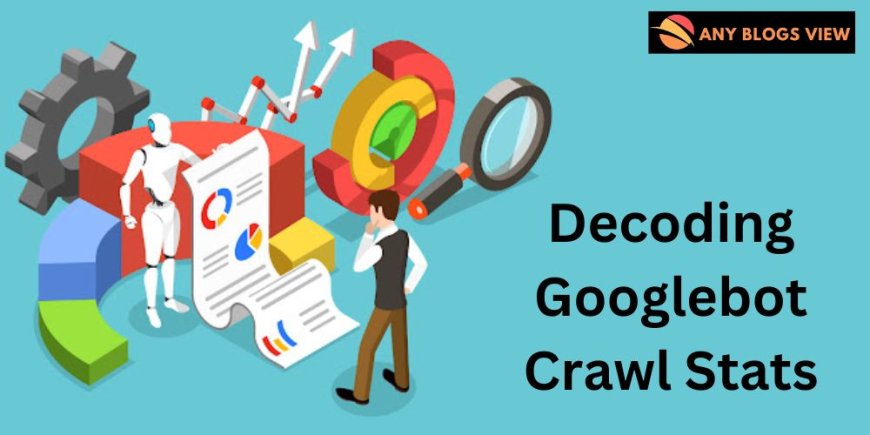Decoding Googlebot Crawl Stats and Recent Updates in Google Search
Decoding Googlebot Crawl Stats

In the ever-evolving world of search engine optimization (SEO), staying updated on Google’s latest changes is essential. Recent updates such as new crawl stats, AI integration, and updates in Google Search Console offer insights and opportunities for webmasters and digital marketers. This article decodes these updates and provides an overview of their impact on search visibility and performance.
1. Decoding Googlebot Crawl Stats
Decoding Googlebot Crawl Stats - Googlebot is the web crawler used by Google to index pages on the internet. Monitoring its activity is essential for understanding how Google interacts with your website. Google Search Console provides crawl stats that help webmasters track the performance and health of their site.
Key Metrics in Crawl Stats:
- Total Crawl Requests: This metric shows the number of pages crawled by Googlebot within a specified timeframe.
- Download Size and Time: Knowing how much data Googlebot downloads and how long it takes can reveal potential issues with site performance.
- Crawl Errors: These highlight problems such as 404 errors, server errors, or blocked resources that hinder proper indexing.
Why Crawl Stats Matter:
Understanding crawl stats allows webmasters to optimize their site for better indexing. If Googlebot struggles to crawl a website, the chances of ranking in search results decrease. Regular monitoring ensures that technical issues don’t impede visibility.
2. Google Adds AI to Search: A New Era of Relevance and Personalization
Google Adds AI to Search - Artificial intelligence (AI) is transforming the way search engines function. Google recently announced the integration of AI into its search results, aiming to enhance relevance, personalization, and user experience.
AI in Search: What’s New?
- Contextual Understanding: AI helps Google understand the context behind queries, making search results more accurate.
- Semantic Search: AI allows the search engine to interpret synonyms, related topics, and user intent rather than just matching keywords.
- Visual and Voice Search Enhancements: AI-powered tools improve image recognition and voice search capabilities, catering to evolving user behavior.
Implications for SEO:
Marketers must now prioritize content that answers user queries comprehensively. AI favors well-researched, engaging content over keyword-stuffed pages. Understanding user intent and creating value-driven content will be crucial for maintaining search visibility.
3. Google Search Console Adds Sticky Filters: Enhanced Usability
Google Search Console recently introduced sticky filters, a small but significant update. This feature allows users to maintain their filter settings across different pages and sessions, improving navigation and usability.
Benefits of Sticky Filters:
- Efficiency: Webmasters no longer need to reapply filters when switching between reports or sessions, saving time.
- Customizable Views: Sticky filters enable users to tailor their experience and focus on metrics that matter most.
- Improved Data Analysis: Consistent filtering ensures that data comparisons remain accurate and relevant.
How to Use Sticky Filters:
To use this feature, simply apply filters in Google Search Console. They will remain in place until manually removed or modified, even after logging out. This enhances workflow efficiency and allows users to focus on key performance metrics.
4. Google Updates Robots.txt Policy: A New Take on Crawling Instructions
Google’s robots.txt file plays a vital role in controlling which parts of a website are accessible to search engines. The latest update to Google’s robots.txt policy emphasizes a more flexible approach to crawling directives.
Changes in Policy:
- Soft 404 Detection: Google will now use AI to interpret soft 404s and adjust crawling behavior accordingly.
- Indexing Signals: The updated policy outlines how Google prioritizes signals from the robots.txt file, meta tags, and HTTP headers.
- Error Handling: Improved error detection helps Google handle incorrect directives more efficiently.
Best Practices for Robots.txt:
Webmasters should ensure their robots.txt files are free from syntax errors and use clear directives. Blocking unnecessary resources, such as internal scripts, can improve crawl efficiency. However, avoid blocking essential assets like CSS and JavaScript files needed for rendering pages.
5. Google Discover Not Showing New Content: What’s Happening?
Google Discover Not Showing New Content feed, is designed to surface articles based on user interests. However, some users and webmasters have noticed that new content is not appearing as expected.
Possible Reasons:
- Content Relevance: Google prioritizes content that aligns with user interests and search history, which might delay the visibility of newer content.
- Technical Issues: Errors in schema markup or missing metadata can prevent content from being featured.
- Algorithmic Changes: Google frequently updates Discover’s algorithms, which may affect how and when content appears.
Optimizing for Google Discover:
To increase the chances of appearing in Discover:
- Focus on high-quality, engaging content.
- Use compelling headlines and visuals.
- Ensure mobile-friendliness and fast loading times.
- Implement structured data to help Google understand the content better.
6. Best AI-Powered Search Engines: Beyond Google
While Google remains dominant, several other AI-powered search engines are gaining popularity, offering innovative features and privacy-focused options.
Notable AI-Powered Search Engines:
- Microsoft Bing: Leveraging AI for enhanced search relevance, visual search, and integration with tools like ChatGPT.
- Neeva: A subscription-based search engine that uses AI to provide ad-free, personalized search results.
- You.com: Offers customizable search experiences, allowing users to prioritize specific sources and content types.
- DuckDuckGo: Focuses on privacy while integrating AI for smarter searches without tracking user data.
Choosing the Right Search Engine:
While Google’s AI-powered tools lead the market, exploring alternatives can provide unique insights and advantages. Privacy-conscious users or those seeking niche results may prefer platforms like DuckDuckGo or Neeva.
Conclusion:
The recent updates in Google’s ecosystem—from crawl stats to AI integration and new policies—underscore the importance of staying agile in SEO strategies. Understanding Googlebot’s behavior, leveraging AI advancements, and optimizing for Discover and robots.txt directives are essential steps for webmasters and digital marketers.
What's Your Reaction?





















